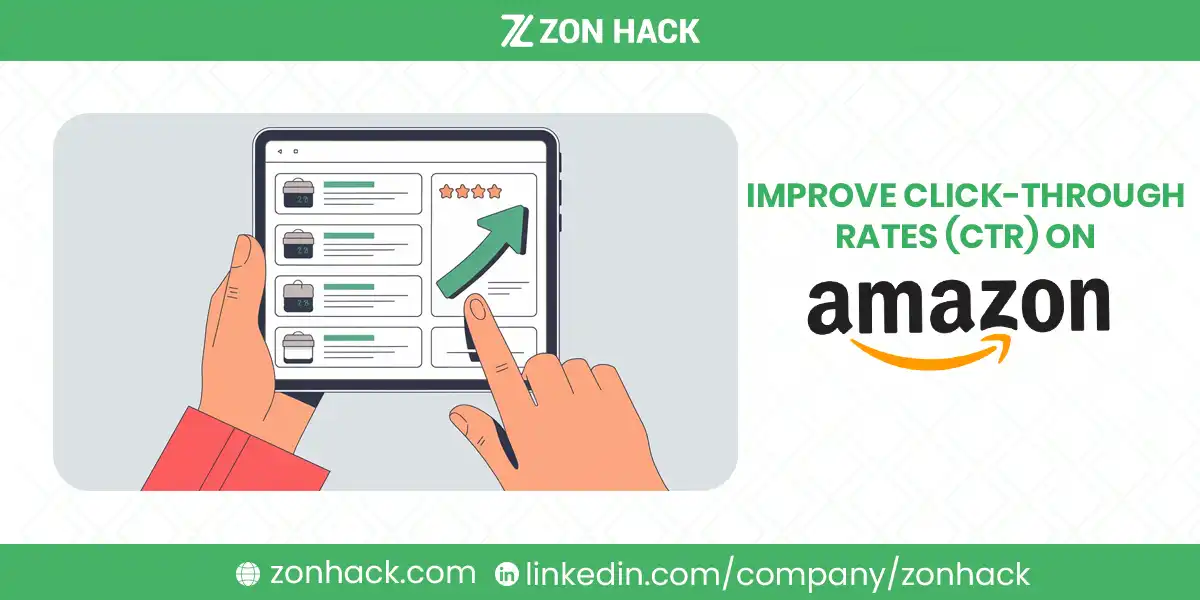Tired of your Amazon products getting lost in the sea of search results? A low Click-Through Rate (CTR) can significantly impact your sales and overall Amazon success. This guide will equip you with actionable tactics to optimize your product listings, increase visibility, and drive more clicks. By implementing these strategies, you can attract more potential customers, boost your sales, and gain a competitive edge in the Amazon marketplace.
What is Click-Through Rate
Click-through rate (CTR) is a fundamental metric for Amazon sellers aiming to maximize their sales potential. In essence, CTR measures the percentage of people who click on your product listing or advertisement after viewing it. It is calculated using the formula:
CTR = (Number of clicks / Number of impressions) x 100.
For sellers, a high CTR signifies strong relevance and appeal, translating into better organic rankings, lower advertising costs, and more sales. Amazon’s A9 algorithm prioritizes products that demonstrate a higher CTR because it interprets this as evidence of user interest and satisfaction. Conversely, a poor CTR can indicate misalignment with customer expectations or weak listing elements, leading to diminished visibility and performance.
Amazon’s benchmarks provide useful guidance. The average CTR for Amazon ads hovers around 0.4%, with anything above 0.5% considered strong. If your CTR is below 0.3%, it is a clear signal that your listing or ad requires improvement.
How CTR Works on Amazon
CTR is more than just a number; it reflects your product’s ability to capture attention amidst thousands of competitors. Let’s explore why it matters and the key factors influencing it.
- Impact on Organic Ranking: A higher CTR signals to Amazon that your listing aligns well with user intent, leading to improved organic visibility. Products with strong CTRs often climb higher in search results, giving them an edge over competitors.
- Ad Performance and Costs: Ads with higher CTRs not only perform better but also benefit from reduced cost-per-click (CPC). Amazon rewards ads that drive clicks with more prominent placements at lower costs.
- Sales and Revenue: The more customers who click on your listing, the greater your chances of converting those clicks into purchases. This means CTR directly influences your bottom line.
Which Factors Influence CTR on Amazon
However, CTR doesn’t exist in a vacuum. It is influenced by a range of factors:
- Relevance to Search Terms: Your product must match the intent behind a user’s search query.
- Product Image Quality: High-resolution, professional images grab attention and build trust.
- Optimized Product Titles: Titles must balance clarity, keyword relevance, and appeal.
- Ratings and Reviews: Star ratings above 4.0 and numerous positive reviews boost credibility.
- Competitive Pricing: A well-priced product stands out in search results.
- Fulfillment Method: Prime-eligible products often attract more clicks.
- Seller Badges: Designations like “Amazon’s Choice” or “Best Seller” increase credibility and visibility.
- Coupons and Promotions: Eye-catching discounts or deals can entice users to click.
- Ad Placement: Ads in premium positions, such as the top of the search results page, tend to garner higher CTRs.
Strategies to Improve CTR on Amazon
Improving CTR requires a multi-faceted approach that enhances the appeal and relevance of your product listings. Below are detailed strategies to elevate your CTR metrics.
1. Keyword Optimization
Effective keyword usage ensures your product appears in the right searches, increasing its chances of being clicked.
- Conduct Thorough Keyword Research: Utilize tools like Helium 10, Jungle Scout, or SellerApp to discover high-volume, relevant keywords. Identify terms that resonate with your target audience and align with their search behavior.
- Target Long-Tail Keywords: Long-tail keywords often indicate higher buying intent and face less competition, making them invaluable for improving CTR.
- Employ Negative Keywords: Exclude irrelevant terms from your ad campaigns to prevent wasted impressions and clicks.
- Strategic Keyword Placement: Incorporate primary keywords seamlessly into your product title, bullet points, and description. This not only improves discoverability but also assures customers that your product matches their needs.
Example: Instead of simply listing a product as “Wireless Headphones,” use a keyword-rich title like “Noise-Canceling Wireless Bluetooth Headphones with 30-Hour Battery Life.”
2. Image Optimization
Your product’s primary image is the first thing a potential customer notices. High-quality visuals can make or break a click decision.
- Invest in Professional Photography: High-resolution, well-lit images that highlight the product’s details are essential. Avoid blurry or overly edited pictures.
- Follow Amazon’s Guidelines: Ensure images have a pure white background, take up at least 85% of the frame, and are at least 1000 pixels on the longest side to enable zoom functionality.
- Use Lifestyle Images and Infographics: Show your product in use to help customers visualize its benefits. Infographics can succinctly convey critical features, such as dimensions or unique selling points.
- Conduct A/B Testing: Experiment with different images to determine which drives higher engagement. For instance, compare an image showcasing just the product versus one showing it in a lifestyle setting.
- Analyze Competitor Visuals: Review the top-performing listings in your category to identify strengths and gaps in their imagery, then adapt accordingly.
Example: For a coffee maker, include a primary image on a white background, a lifestyle image of it being used in a cozy kitchen, and an infographic detailing features like brew strength and timer settings.
3. Listing Optimization
Your product listing must be a magnet for clicks. A poorly optimized listing can deter even the most interested shoppers.
- Craft Engaging Product Titles: A title should be descriptive, keyword-rich, and easy to read. Include essential details like brand, size, color, or unique features.
- Enhance Bullet Points: Use concise yet persuasive bullet points to highlight the product’s features and benefits. Answer common customer questions preemptively.
- Write Compelling Product Descriptions: Use storytelling to connect with your audience. Explain how the product solves a problem or enhances their lives, incorporating relevant keywords naturally.
- Leverage A+ Content: If you’re brand registered, utilize A+ Content to enrich your listing with additional visuals and storytelling elements. Highlight key benefits and provide comparisons.
- Add Product Videos: Videos can dramatically improve engagement by showcasing the product in action, explaining its features, or demonstrating its use cases.
Example: For a yoga mat, create a description like, “Unwind after a long day with this eco-friendly yoga mat, featuring non-slip technology and cushioned support for all poses. Perfect for beginners and advanced yogis alike.”
Analyzing and Monitoring CTR on Amazon
Improving your CTR is an ongoing process that requires consistent tracking and analysis. Monitoring your CTR metrics allows you to identify what works and what needs adjustment. Amazon provides several tools and reports to help sellers analyze their performance.
Amazon Search Query Performance Report
One invaluable resource is Amazon’s Search Query Performance Report, which offers insights into how customers interact with your products. This report provides data on impressions, clicks, and conversions, enabling sellers to track their CTR over time. By identifying which search queries generate the most clicks, sellers can refine their keywords and enhance listing relevance.
Third-Party Tools
Third-party tools like Helium 10, Jungle Scout, and SellerApp also offer comprehensive analytics to track and optimize your CTR. These platforms provide keyword performance data, competitor analysis, and actionable recommendations to boost visibility and engagement. Integrating these tools into your strategy can offer a competitive edge, ensuring your listings remain optimized and effective.
Tracking CTR should be a routine part of your operations. Establish benchmarks based on your category and set realistic goals for improvement. Monitor your progress weekly or monthly, adjusting your strategies as needed to respond to changes in competition, customer behavior, or market trends. Consistent analysis ensures your listings remain relevant and high-performing.
FAQs
What is a good CTR for Amazon listings?
A good CTR on Amazon varies by category, but generally, a CTR above 0.5% is considered strong. If your CTR falls below 0.3%, it’s a sign that your listings may need optimization.
How do keywords impact CTR?
Keywords play a critical role in CTR by ensuring your product appears in relevant search results. Effective keyword placement in titles, bullet points, and descriptions increases visibility and attracts more clicks.
Can A/B testing improve CTR?
Yes, A/B testing is a powerful method to improve CTR. Testing different images, titles, and bullet points helps identify the elements that resonate most with your audience.
Why do product images matter for CTR?
High-quality images create a strong first impression and showcase your product effectively. Clear, professional photos can significantly increase clicks by attracting customer attention.
How does pricing affect CTR?
Competitive pricing makes your product more appealing to customers. Using tools to analyze competitor prices and offering discounts or promotions can boost your CTR.




